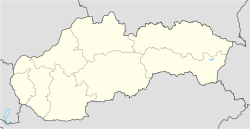Banská Belá | |
|---|---|
Village | |
| Coordinates: 48°28′30″N 18°56′06″E / 48.47500°N 18.93500°E | |
| Country | Slovakia |
| Region | Banská Bystrica |
| District | Banská Štiavnica |
| First mentioned | 1228 |
| Area | |
| • Total | 28.6 km2 (11.0 sq mi) |
| Elevation | 480 m (1,570 ft) |
| Population (2004-12-31) | |
| • Total | 1,234 |
| • Density | 43/km2 (110/sq mi) |
| Population by ethnicity (2011) | |
| • Slovak | 91% |
| • Roma | 0.5% |
| • Czech | 0.3% |
| • Others | 0.2% |
| • Unreported | 8% |
| Population by religion (2011) | |
| • Roman Catholic | 64.7% |
| • Lutheran | 8.9% |
| • Others | 2.8% |
| • Non-religious | 13% |
| • Unreported | 10.6% |
| Postal code | 966 15 |
| Area code | +421-45 |
| Car plate | BS |
| Website | www.banskabela.ocu.sk |
Banská Belá (German: Dilln; Hungarian: Bélabánya) is a village and municipality in Banská Štiavnica District, in the Banská Bystrica Region of central Slovakia. It has a population of 1,234.
YouTube Encyclopedic
-
1/3Views:1 4701 653743
-
Ostalo tu všetko! Opustená továreň Dinas Banská Belá
-
Banská Bela - the Grand Tour
-
Šutrovačka Vyhne,Hliník nad Hronom a Banská Belá 09.-10.08.2019
Transcription
Names and etymology
The settlements got its name after the creek Biela (1228 torrens Bela, now Starý potok), in Slovak "white".[3] The village founded on the creek was named Bana (a mine), later Biela Bana to distinguish between Banská Belá and Banská Štiavnica which was called also Bana.[3] The Hungarian name Feyerbanya and its variations are translations of the Slovak name.[3] The origin of the German name Dill is uncertain.[3]
The first written mention is probably terra nomine bela (1288), older sources mention also an unreliable record terra banensium (1156).[3]
History
The village arose by separation from Banská Štiavnica, but it was part of Banská Štiavnica again from 1873 to 1954.
King Béla IV invited German miners from Banská Štiavnica and the village got the German name Dilln (Dyln, Dilln, Dylen). The village suffered from Turkish raids during the Ottoman wars.
Genealogical resources
The records for genealogical research are available at the state archive "Statny Archiv in Banska Bystrica, Slovakia"
- Roman Catholic church records (births/marriages/deaths): 1688-1895(parish A)
- Lutheran church records (births/marriages/deaths): 1678-1905(parish B)
See also
References
- ^ SODB - Banská Belá, 2011
- ^ SODB - Banská Belá, 2011
- ^ a b c d e Martin Štefánik - Ján Lukačka et al. 2010, Lexikón stredovekých miest na Slovensku, Historický ústav SAV, Bratislava, p. 20, ISBN 978-80-89396-11-5. http://forumhistoriae.sk/-/lexikon-stredovekych-miest-na-slovensku Archived 2017-03-26 at the Wayback Machine
External links
- Official website of Banská Belá (in Slovak)
- Basic information about Banská Belá (in Slovak)
- Surnames of living people in Banska Bela

